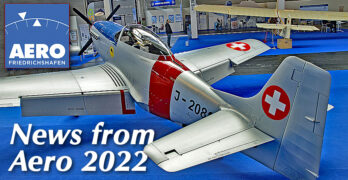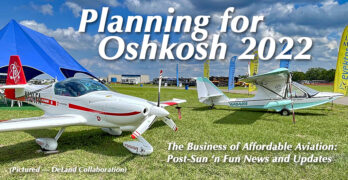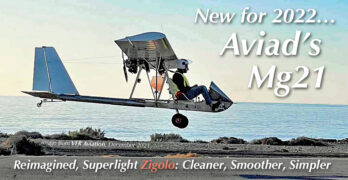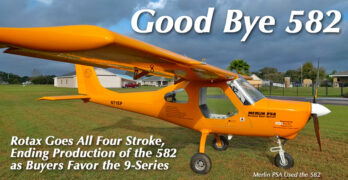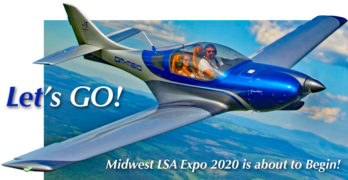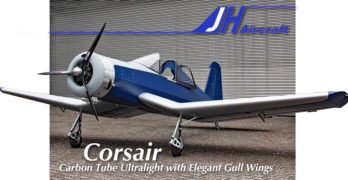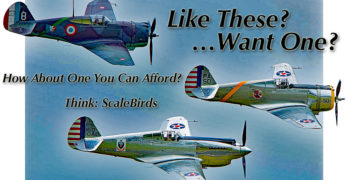Sun ‘n Fun started the recreational flying season as it always does, taking place this year in the beginning of April. Aero Friedrichshafen ended the month at the end of April. These two shows make April the strongest month of the year for airshows, certainly for the affordable aviation crowd.
Aviation journalist and LAMA board director Marino Boric was able to find many worthy stories at the popular German show.
People that know Marino — many of you pilots, but nearly every producer — are aware he is an energetic, superbly-informed, and technically-competent individual. I am pleased to present his work in this and additional articles to follow from the recently-completed Aero Friendrichshafen show in southern Germany.
In this article, Marino provides a short bit about six interesting projects. Some of these you know; some you don’t.
I hope you enjoy Marino’s quick tour. Look for more… soon.
Search Results for : four-stroke
Not finding exactly what you expected? Try our advanced search option.
Select a manufacturer to go straight to all our content about that manufacturer.
Select an aircraft model to go straight to all our content about that model.
NEWS Update — Started at Sun ‘n Fun… Preparing for AirVenture Oshkosh 2022
My moment of truth is fast approaching. Will I succeed or fail to predict the future?
I have been repeating my forecast that FAA will announce a draft of their newest regulation, called an NPRM (Notice of Proposed Rule Making) at EAA’s big summer celebration of flight. I’m not betting the farm, though. I think it’s a fairly safe prediction.
To win an increase in their budget a few years back, FAA agreed to complete a new regulation by December 31, 2023. That new reg is widely known as Mosaic; its full name is Modernization of Special Airworthiness Certification. Because FAA has said the agency needs 16 months to read every comment and adjust the final regulation language accordingly, seeing the future is simple math. Go back in time 16 months from the end-of-year deadline in 2023 and you end up at… yep! — AirVenture Oshkosh 2022. We will see if they meet their goal.
Do You Love Ultralights but Prefer a Four Stroke Engine? Find It at Sun ‘n Fun!
A year ago at Sun ‘n Fun 2021, I reported on a Rotax 503 replacement built in Russia. This information was warmly received at the time because the 503 powerplant was much beloved by ultralight enthusiasts.
Little did we know last year that Putin would invade Ukraine and plunge both countries into disarray. The RMZ 500 engine seemed to promise a return to the popular engine. It will surely be months if not years before we see more of them.
Despite the former popularity of the Rotax 503 fifteen years ago, one of the most common questions asked of Part 103 producers today is, “Can you provide a four-stroke engine?”
It’s not an easy order to fill; two-strokes are potent sources of power at minimal weight, what’s called power-to-weight ratio. Any four-stroke engine is hard pressed to match the power-to-weight ratio of the best two-stroke engines.
At Sun ‘n Fun 2022, Gene “Bever” Borne and son Ken of Air-Tech Inc.
Aviad’s Reimagined Zigolo Ultralight for 2022; Welcome to Mg21
Americans know Zigolo thanks to U.S. importer, Chip Erwin. He brought the genuine Part 103 ultralight to the USA but also to other countries where he found customers. Those who know Chip are aware he has many international connections.
Beside importing aircraft to the USA and helping customers build them, Chip experimented with electric propulsion for Zigolo.
In short, he did a lot for Italian producer Aviad but Chip is now focused on his Merlin PSA and Merlin Lite plus his Hybird V-Twin, 60 horsepower, four stroke engine. You’ll be hearing more about that as Sun ‘n Fun 2022 approaches.
Welcome to Zigolo Mg21
Check out earlier articles on Zigolo — here’s a full pilot report — but know this: While Mg21 shares the name Zigolo, nearly everything about the new model from Aviad developer Francesco Di Martino is different.
Big Producer of Small Engines — Rotax Reaches a Major Production Benchmark
Two decades into the new millennia, few aviation companies can claim impressive growth. In two decades, one company that everyone now recognizes as a climber is Cirrus Design and their successful SR-series of general aviation aircraft.
Back in 1998 many pilots were doubtful about Cirrus.
I was close to the company during these years. Over and over I heard statements such as: “They’ll never complete the design.” “They’ll never get FAA to approve it (especially with that parachute on board).” “They’ll never raise the money to produce it.” “They’ll never get production to a profitable level.” “They’ll never develop beyond a single model.” Those doubters were wrong on all counts.
Only a few years earlier, in 1992, Americans got their first glimpse of the 9-series Rotax engine. At the time, many aviation mechanics dismissed it as “…just a snowmobile engine.” They also turned out to be wrong.
Starting with their lightweight, advanced-technology, liquid-cooled, 80-horsepower engine, Rotax developed a line of powerplants and went on to dominate the light aircraft aircraft market globally.
AirVenture Day 0: Say Good-Bye to Rotax Two-Stroke Aircraft Engines
As AirVenture Oshkosh 2021 starts, we have arrived at a long-awaited beginning to the world’s biggest airshow.
AirVenture Oshkosh 2021 opens Monday July 26th and I am on-site to capture all the best news I can find for light aircraft.
Regretfully, my Canada-based YouTube partner, Videoman Dave, was denied entry by Homeland Security — his occupation was “deemed not essential” — so I’ll be flying solo to write daily articles and record video.
End of an Era?
As a company news release issued just before Oshkosh shows, we have also arrived at the end of an era. Rotax announced that the Austrian engine manufacturer will cease production of their last two-stroke powerplant, the twin-cylinder, 65-horsepower 582.
Indeed, as light aviation enthusiasts prepare for the coming Mosaic regulation that will dramatically alter the landscape, a clearer dividing line is revealing itself. Many light aircraft have embraced Rotax’s four stroke engines, overwhelmingly their 9-series models including carbureted 912 ULS, fuel-injected 912iS, turbocharged 914, and the newest 915iS.
Rotax 915iS Proves a Winner — “Best Powertrain Concept in the Light-Sport Aviation Industry”
How does modern-day Rotax relate to the Wright Brothers? Here’s a trivia test for light aviation enthusiasts.
Answer: Both started out in the bicycle business.
A little over a year ago, the engine builder from Gunskirchen, Austria celebrated their 100th anniversary. Check this article that contains a link to a beautifully-presented history of the company. It also describes how the company got its name.
In production for more than 30 years, Rotax’s 9-series engine design was a significant departure from earlier aircraft engines.
The 9-series is physically smaller, uses liquid cooling, an electronic control unit, and a gearbox to change engine revolutions from 5,000 rpm to slower speeds that work for props. The 912 enjoys a much better power-to-weight ratio than familiar models such as Lycoming’s O-233. That veteran engine produces 100 horsepower (at 2300 rpm; higher power is available at increased revolutions) using 233 cubic inches of cylinder displacement.
Midwest Light-Sport Aircraft Expo — What to See at 2020’s Last Airshow
I hope you can attend 2020’s Midwest LSA Expo — the last airshow in 2020. If you cannot attend, rest assured your trusty reporter will be onsite and gathering all the info on the coolest aircraft I can find.
What will be available? Well, if I am honest, we will have to see when we arrive to be certain. In these virus-impacted times, things have a lousy way of changing at the last minute, however…
Those who attend should see a few aircraft that few Americans have seen before. Here’s a quick take, not forgetting the statement about how arrivals can be altered beyond the wishes of any particular vendor.
Rare and/or New Aircraft
MC-01 by Montaer — We almost didn’t see it. Insurance has been getting harder to find and more costly. That’s true for all aircraft but the situation is especially challenging for a new design (even if it significantly resembles an earlier design).
All Carbon Fiber (Structure) Part 103 Ultralight Aircraft — Corsair is Coming to America
Most ultralight aircraft (officially: “ultralight vehicles”) are rather simple constructions. They must be to stay within the tight constraints of a 254-pound maximum empty weight.*
That’s not a negative comment about them. Actually, it’s the opposite.
To build a flying airplane that weighs less than the engine alone on a Light-Sport Aircraft, a designer has to be unusually clever.
All aircraft are constrained in weight by the laws of physics. Ultralights are further constrained by regulation.
A key way to keep an aircraft light is to keep it simple. Indeed most 103 ultralights are quite basic. However, as years passed some engineers have found intriguing solutions. I recently wrote about the composite Swan. Why not one using extensive carbon fiber?
Carbon Corsair
German developer Jörg Hollmann took a different approach, one that consumed a few years of effort.
He wanted an aircraft that resembled the famous World War II F4U Corsair fighter.
Vintage Light Kit Aircraft Heaven — Checking out ScaleBirds’ Curtis P-36 with 5-Cylinder Engine
ScaleBirds is not your run-of-the-mill kit aircraft company. In truth, all kit builders are amazing to me.
People who labor for years to design an aircraft, craft methods for making the constituent parts, assemble it all, work out bugs in construction, fly the aircraft, then smooth any rough edges of its flight qualities, start producing kit components — and the manual it will take for a non-expert to build the kit (perhaps the hardest task) — and finally, start the effort of telling people about the airplane, market it, sell it — and the big one — try to turn a profit for doing all the preceding. Any way you cut it, birthing a new design is an immense project.
Sam Watrous, his son Scott, and their merry band of (mostly volunteer) ScaleBirders are not merely doing all the above. They are emulating vintage American military designs in reduced scale and trying to get the details right so the kit versions look as much as possible like the originals.
- « Previous Page
- 1
- 2
- 3
- 4
- 5
- …
- 13
- Next Page »


